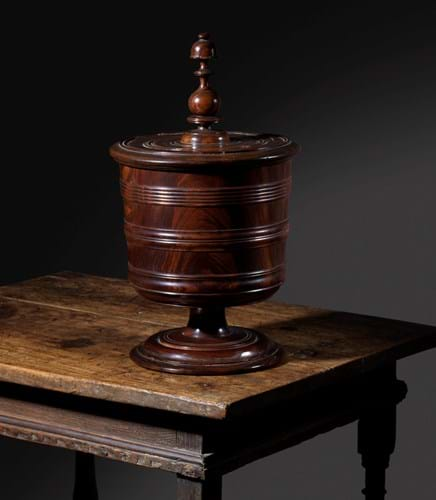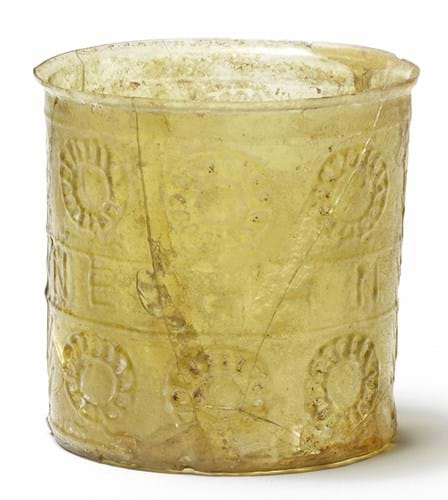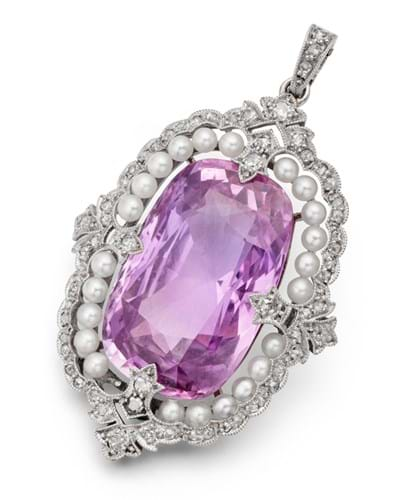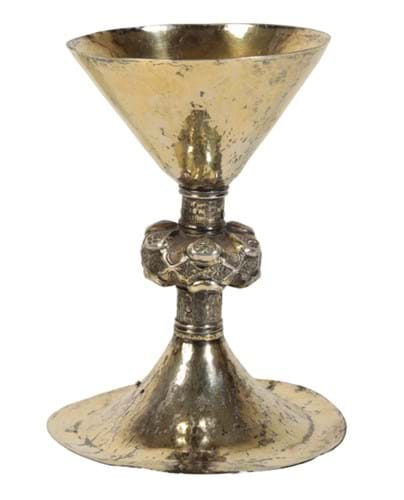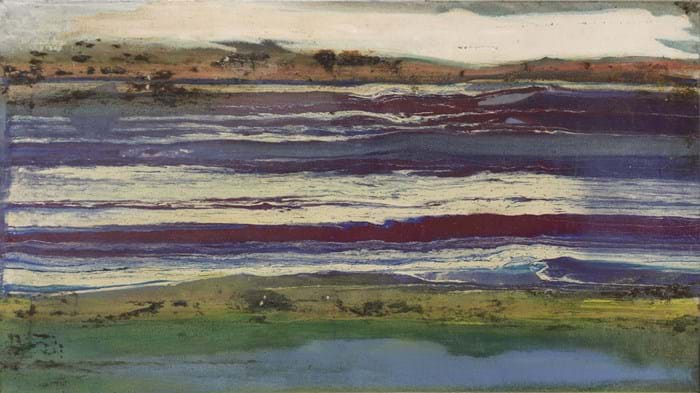1. Charles II wassail bowl and cover – £8500
Among the highlights of the first day of Woolley & Wallis’ Furniture and Works of Art sale on July 6-7 was this wassail bowl and cover. A textbook Charles II example made in lignum vitae c.1660-70, it came for sale from the estate of Peter Mactaggart (1931-2020) whose family ran an antiques shop in Welwyn, Hertfordshire from the late 1940s to the early 1970s.
Remarkably the lid retains, to the underside, its brass and Surrey enamel type roundel or 'print' depicting the Royal Coat of Arms of Charles II. When the piece was featured in Apollo magazine in December 1936 as part of an article titled ‘The Wassail Bowl and the Custom of Wassailing at Christmas Time’, the author Owen Evan-Thomas wrote: 'This is the only wassail bowl I have ever seen containing under the lid its original ‘print’.
Estimated at £6000-8000, it sold at £8500.
2. Roman glass ‘Victory’ beaker – £20,000
This Roman amber glass beaker is decorated with six stylised victory wreaths and the inscription in Greek ‘Seize the Victory’. It belongs to a group of similar mould blown beakers from the early-mid 1st century AD which appear to have been used in drinking games to celebrate feats in games, chariot races or gladiatorial contests. Perhaps made in workshops near Sidon, on the Phoenician coast, they have been found in Cyprus, Greece, Sardinia and Panticapaeum in the Crimea.
It came for sale at Bonhams’ Antiquities sale on July 6 from a US private collection of ancient glass. Previously part of the celebrated Constable-Maxwell collection of ancient glass sold at Sotheby’s in 1979 and later the British Rail Pension Fund sale (Sotheby's 1997), it has spent time on loan to both the Victoria & Albert Museum (1980-85) and the Corning Museum of Glass (1985-95).
Guided at £20,000-30,000, it got any at the low end of expectations.
3. Art Deco diamond pendant – £156,000
The central stone to this Art Deco seed pearl and diamond pendant, offered for sale at Lyon & Turnbull’s Jewellery & Watches sale in London on July 1, is an elongated cushion-shaped pink sapphire, weighing approximately 25ct.
It is accompanied by a GCS report stating that it is a natural gem, with no indications of heating, with a probable Sri Lankan origin.
The 4.4cm pendant was formerly the property of Marija Barachutė, who was born in Lithuania in 1911 in a mining community but moved to Glasgow when still a small child. After changing her name to Mary Barclay, she left Glasgow for America at the age of 16 and she settled in Chicago. She lived there for about five years – probably acquiring this pendant that is almost certainly of American manufacture – before returning to Scotland.
Highly saturated medium pink tones such as this are considered among the best pink sapphires. It was estimated at £4000-6000 but sailed away to reach £156,000.
4. Irish silver gilt chalice – £38,000
This 6.5in (16cm) Irish silver gilt chalice dating from c.1480 is a rare survivor from before the Reformation. It came for sale at Duke’s in Dorchester on July 1 by descent from Wilson Rae-Scott, a financier from Chiswick, who collected silver and works of art in the years before the Second World War.
The fact that Henry VIII’s religious reforms in Ireland did not always go much further than The Pale, the area immediately surrounding Dublin, may account for the survival of much Irish pre-Reformation plate.
Dr Edith Andrees of the National Museum of Ireland, who helped in the cataloguing of the piece along with former Victoria & Albert Museum curator Philippa Glanville, suggested the chalice may been made in or around Cork. Comparable examples from the same period include the Matheus Macraith chalice in Clonfert, Galway and the De Burgo-O’Malley chalice in the NMI. These both have a spreading octagonal foot.
The Rae-Scott cup has a less typical spreading circular foot with rivet holes indicating a now lost mount that would have depicted an image, inscription or corpus. Against a guide of £5000-10,000, it took £38,000.
5. 1857 US Presidential lifesaving medallion – £7200
The sale at Bentley’s in Cranbrook, Kent on July 3 included this rare US Presidential lifesaving medallion. It is one of 21 struck at the request of President Franklin Pierce as an award to the rescuers of the Northern Belle, an American freighter that foundered off Thanet in a snow storm on January 5 1857.
The rescue attempts resulted in the loss of eight lifeboat men but every crew member from the Northern Belle was saved. Word of this made it back to the United States and President Pierce commissioned the medallist Koehler to design and mint a medal.
Each medal was engraved with one of the 21 recipient’s names and was awarded along with a cash reward. This medal is engraved in the name of John Fox.
The last example to appear at auction in the UK sold at Dix Noonan & Webb in 2016 for £4600. Bentley’s example, in its original moulded bois durci case, took £7200 (estimate £3000-5000).
6. Frank Bowling acrylic painting – £190,000
In 1987 Frank Bowling (b.1934) made history as the first artist of Afro-Caribbean descent to have their work enter the Tate Collection and again in 2005 when he was elected the first black Royal Academician in the institution's history. In last year’s Queen's birthday honours, he received a knighthood, aged 86.
Born in what was then British Guyana in 1934, Bowling moved to London aged 19 and after a few years was accepted to study at the Royal College of Art. There, alongside David Hockney and Allen Jones, he became part of the generation of students whose emergence announced a shift in the prevailing fashion from Fifties abstraction to Sixties pop.
This 2ft x 3ft 7in (61cm x 1.09m) acrylic on canvas titled Potaroway 1975 is from the period when Bowling, having returned to London after decade in New York, was developing his ‘poured’ painting method. Many of these take titles from Guyanese locations – this one named after Potaro, the vast river which winds its way 140 miles east from its source at Mount Ayanganna.
Offered for sale at Bonhams’ Modern British and Irish art sale on June 30 the first time since its acquisition at Sotheby’s Chelsea Arts Club Auction in 1988, it was guided at £80,000-120,000 but sold at £190,000. The price was the third highest for a picture by Bowling at auction (source: Artprice by Artmarket).


